We have talked about the working principle of chromatic confocal sensor (confocal displacement sensor). It has the following advantages on measurement.
1. Support measuring surfaces in different forms: Specular, curved, tilted, rough, transparent, droplet surfaces, etc.
2. No shadow areas: With the light coming from all directions, the surface of the object can always receive the light without shadow areas.
3. High resolution: In theory, the wavelength can be subdivided continuously. And the ideal lenses have very high resolution.
4. Good temperature stability: The lens itself does not emit heat, and thus has small temperature drift. For micron and submicron measurements, the temperature drift is essential.
5. Automatic focus: Within the measuring range scope, the light with the corresponding wave length will be focused on the surface of the object when the object to be measured moves up and down.
6. High lateral resolution: The object to be measured is always located at the focus when it is moved from top to bottom and the measured light spot is small. And the chromatic confocal principle can resolve small changes in the outline of the object to be measured.
7. Modular miniaturization: The lens and controller can be connected through the optic fiber, with a long transmission distance. The lens can be produced as small as possible, so as to be installed side by side.
8. Frequency modulation anti-jamming: The wave length is a frequency modulated signal and is insensitive to amplitude modulation jamming such as the light intensity change. The optic fiber is insensitive to the electromagnetic interference and lightning surge.
9. Measurement of thickness of transparent materials: When the object to be measured is transparent and has two surfaces, two beams of light with different wave lengths will be reflected back and then the thickness value will be gained.
10. Multi Perceives: In theory, any ray of light returning onto the spectrum analyzer carries on the distance information through the wave length, and part of the light that is shielded has small influence.
11. High safety: LED light source with long service life and the white light with tiny power are safer to human eyes than the laser and are not restricted by the laser hazard rating.
12. High protection: The controller is provided with high protection level and the optic fiber can be provided with a stainless steel cover, so as to prevent from biting of pests and rats.
Comparing to traditional laser displacement sensor, what are its advantages?
1. No shadow areas
Laser Displacement Sensor

The height change is mapped to the image displacement on the sensor and the height distance will be calculated according to the trigonometric function. The shadow area in the figure is the unmeasurable area.
Chromatic Confocal Sensor

The light is irradiated from multiple directions and coaxial measurement is carried out. If few beams of light return, the measurement can be carried out for the hole and tank bottom. A
sensor can replace 4 laser distance sensors irradiating light from different directions, which saves the cost significantly.
2. Support measuring transparent materials or specular surfaces
Laser Displacement Sensor

It is verified that the transmission of the semitransparent materials has deviations. It is very difficult to measure the transparent materials and mirror plane materials.
Chromatic Confocal Sensor

The diffuse reflection light around the light spot on semitransparent materials is blocked by the hole and cannot be returned to the spectrum analyzer, thus it will not influence the measurement. The transparent surface can also reflect part of the light. Therefore, the measurement can be carried out, even for multiple layers.
3. Support measuring tilted surface
Laser Displacement Sensor

When the mirror plane is measured with triangulation method, a special model or specific angle is required and the measurement location can change along with the height change. When the surface is inclined or bent to a certain degree, no light to be measured will be returned.
Chromatic Confocal Sensor

Within a relatively large bending or inclined angle, only if a fraction of the light can be returned, the mirror plane can be correctly measured without change in the model or installation angle. In this way, it reduces required sensor types or halves the required number of sensors and thus saves the cost.
4. Small spot size, high resolution
Laser Displacement Sensor

The spot of the laser is only fine at the focus and it will become larger at other places other than the focus, and thus the measurement area becomes larger. There is no certainty within the sampling area and the precision is poorer.
Chromatic Confocal Sensor

Within the measuring range scope, the light of effective wave length to be measured is always located at the focus and the light spot is fine and small. The resolution and precision can be kept within the full range.
Compared with laser, the LED light source that the chromatic confocal products adopt is safer to the human eyes, and has no speckle interference caused by the laser interference; and in addition, it has higher precision and smaller size for easy installation (about 1/200 of the traditional laser distance sensor at minimum). Several manufacturers of traditional laser distance sensors have launched chromatic confocal products to replace traditional products. The chromatic confocal products have been recognized as the replacement products of laser products.

